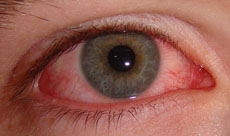Conjunctivitis
Contents
General Information
Causes
Symptoms
Exams and Tests
Treatment
Outlook (Prognosis)
Possible Complications
When to Contact a Medical Professional
Prevention
Alternative Names
General Information
Conjunctivitis is swelling (inflammation) or infection of the membrane lining the eyelids (conjunctiva).
Causes
The conjunctiva is exposed to bacteria and other irritants. Tears help protect the conjunctiva by washing away bacteria. Tears also contain proteins and antibodies that kill bacteria.
There are many causes of conjunctivitis. Viruses are the most common cause. Viral conjuctivitis is referred to as "pink eye." Pink eye can spread easily among children.
Other causes include:
- Allergies (allergic conjunctivitis)
- Bacteria
- Certain diseases
- Chemical exposure
- Chlamydia
- Fungi
- Parasites (rarely)
- Use of contact lenses (especially extended-wear lenses)
Newborns can be infected by bacteria in the birth canal. This condition is called ophthalmia neonatorum, and it must be treated immediately to preserve eyesight.
Symptoms
- Blurred vision
- Crusts that form on the eyelid overnight
- Eye pain
- Gritty feeling in the eyes
- Increased tearing
- Itching of the eye
- Redness in the eyes
- Sensitivity to light
Exams and Tests
- Examination of the eyes
- Swab of conjunctiva for analysis
Treatment
Treatment of conjunctivitis depends on the cause.
Allergic conjunctivitis may respond to allergy treatment. It may disappear on its own when you avoid your allergy triggers. Cool compresses may help soothe allergic conjunctivitis.
Antibiotic medication, usually eye drops, is effective for bacterial conjunctivitis. Viral conjunctivitis will disappear on its own. Many doctors give a mild antibiotic eyedrops for pink eye to prevent bacterial conjunctivitis.
You can soothe the discomfort of viral or bacterial conjunctivitis by applying warm compresses (clean cloths soaked in warm water) to your closed eyes.
Outlook (Prognosis)
The outcome is usually good with treatment.
Possible Complications
Reinfection within a household or school may occur if you don't follow preventive measures.
When to Contact a Medical Professional
Call for an appointment with your health care provider if your symptoms last longer than 3 or 4 days.
Prevention
Good hygiene can help prevent the spread of conjunctivitis:
- Change pillowcases frequently.
- Do not share eye cosmetics.
- Do not share towels or handkerchiefs.
- Handle and clean contact lenses properly.
- Keep hands away from the eye.
- Replace eye cosmetics regularly.
- Wash your hands often.
Alternative Names
Inflammation - conjunctiva; Pink eye



 Общие симптомы
Общие симптомы  Голова, зрение, слух, речь
Голова, зрение, слух, речь  Шея и горло
Шея и горло  Грудь, сердце и дыхание
Грудь, сердце и дыхание  Живот, желудок, кишечник
Живот, желудок, кишечник  Конечности, суставы, спина, поясница
Конечности, суставы, спина, поясница  Таз, мочеполовые органы
Таз, мочеполовые органы  Наружные поверхности, кожа, волосы
Наружные поверхности, кожа, волосы